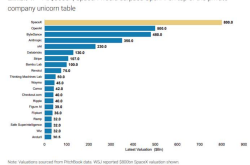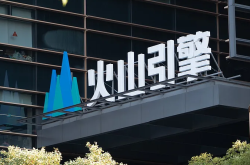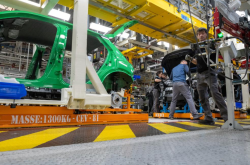Keysight Technologies Unveils KAI Full-Stack AI Testing Solution, Focusing on AI Computing Power and 6G Technology Advancements
![]() 07/17 2025
07/17 2025
![]() 563
563
On June 26, 2025, Keysight Technologies, a pioneering global provider of test and measurement solutions, hosted the Keysight World Tech Day 2025 media event in Shanghai. At this event, the company officially launched the KAI (Keysight AI) solution for the comprehensive lifecycle of AI (Artificial Intelligence), offering an in-depth exploration of the challenges faced by data centers and detailing Keysight's strategic technological layout. This marks a systematic breakthrough by Keysight in the realm of AI computing measurement.
Currently, the dual technological trends of rapid AI development and nascent 6G research dominate the landscape. Kailash Narayanan, Senior Vice President and President of Keysight Technologies' Communications Solutions Group, highlighted at the event that AI has materialized and garnered substantial investments, while 6G, the next frontier in wireless innovation, is emerging and still in its early research phase. Keysight Technologies is dedicated to collaborating closely with industry partners and global clients to jointly propel technological advancement. He emphasized China's leadership in innovative fields such as AI, 6G, high-speed trains, and electric vehicles, with investments in AI and robotics technologies reaching approximately $100 billion in 2024.
With the explosive growth of AI computing power, the industry grapples with efficiency bottlenecks and reliability crises.
Early AI primarily served recognition functions, leveraging modest computing power, parameters, and data scales—models could be constructed with mere dozens of boards and a few hundred gigabytes of data. However, contemporary large model parameters have surged from hundreds of billions to trillions, and computing clusters have expanded from thousands to tens of thousands, hundreds of thousands, or even up to two hundred thousand cards. This scale expansion aims to empower models to generate more precise content.
The industry perceives that the current AI sector is at a historic turning point. According to Bloomberg data, the global AI market size is projected to skyrocket from $86.9 billion in 2022 to $1.3 trillion by 2030. Nonetheless, this rapid development is shadowed by formidable challenges.
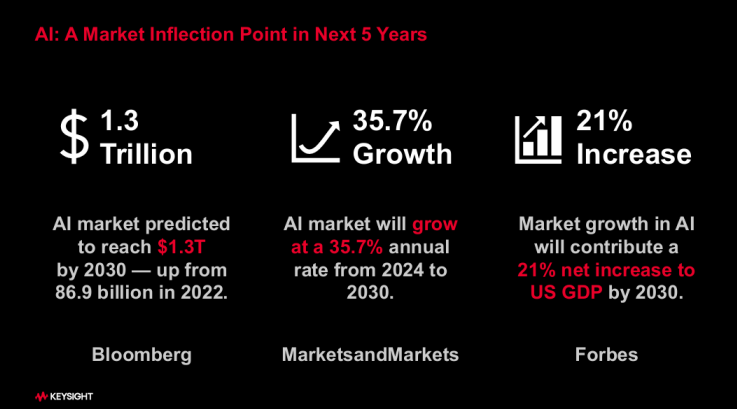
In his opening address, Kailash Narayanan noted that AI data centers and 6G technology are fueling a global wave of innovation, yet the underlying infrastructure confronts severe challenges, including bottlenecks in computing power utilization, hardware reliability crises, and the contradiction between bandwidth and power consumption.
Computing Power Utilization Bottlenecks: During AI training, GPUs are actively engaged in "work" (20% computation, 16% overlapping processing, and 2% memory operations) for only 38% of the time, with the remaining 62% spent in a waiting state due to data transmission delays.
Hardware Reliability Crisis: The failure rate of ultra-large-scale cluster training tasks exceeds 43%, primarily due to reliability issues of high-speed devices operating at physical limits.
Bandwidth and Power Consumption Contradiction: Optical modules must overcome transmission distance limitations, and 224G high-speed signals face triple pressures of PCB loss, heat dissipation, and power consumption.
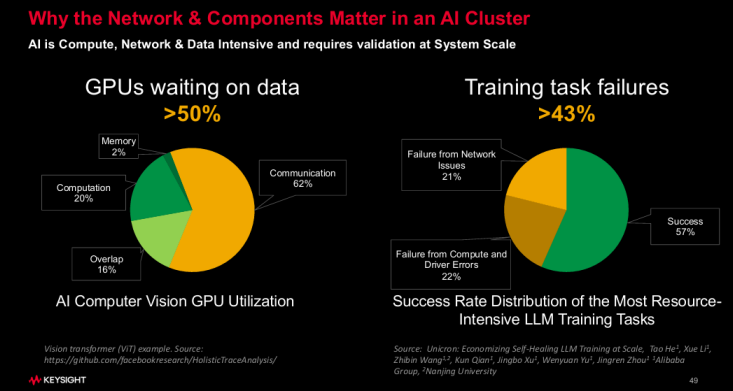
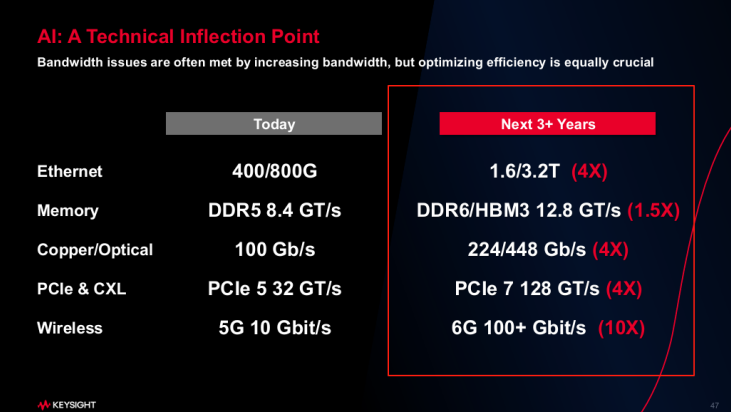
Li Jian, High-Speed Digital Market Manager of Keysight Technologies in Greater China, emphasized in his speech that as data rates evolve to 1.6T and 3.2T, the transmission loss of high-speed cables increases dramatically, posing severe challenges to effective transmission distance. For instance, cables supporting 800G data rates typically need to be controlled at around 0.5 meters, and at higher data rates, this distance may shrink to 0.2-0.3 meters, imposing stricter requirements on system design.
Keysight's KAI solution transcends traditional methods by reconstructing the full-stack verification system for AI infrastructure.
According to Li Jian, despite substantial investments in AI data center infrastructure, the industry grapples with prominent efficiency issues. As previously mentioned, research data indicates that GPUs are actively engaged in model training for only about 38% of the time, with over 50% spent in a waiting state, primarily due to inadequate network bandwidth and data transmission congestion. Simultaneously, due to insufficient hardware reliability or software failures, the one-time completion rate of large model training tasks stands at only about 57%.
To address these challenges, Keysight Technologies has introduced a revamped AI product matrix—Keysight AI (KAI), which tackles industry pain points through four technical dimensions.
The official introduction reveals that the KAI solution encompasses the entire AI technology stack, aiming to provide customers with a comprehensive lifecycle solution spanning design, simulation, and testing, thereby facilitating the construction of a more stable, reliable, and efficient computing power infrastructure.
KAI Compute: For computing boards, it offers evaluation tools for high-speed devices, including computing, storage, and interface routing, contributing to the creation of more stable and reliable computing power.
KAI Interconnect: For high-speed interconnect devices, such as cables, optical modules, and optical connections linking computing boards, it provides solutions like network analyzers, sampling oscilloscopes, and high-speed bit error rate testers.
KAI Network: Leveraging the technical prowess of Ixia, acquired by Keysight Technologies for $1.6 billion in 2017, it offers comprehensive testing solutions from the network layer to the application layer for networking equipment like network cards and switches.
KAI Power: It presents various solutions for power devices in data centers (e.g., AC/DC and DC/DC converters), optimizing power conversion efficiency to reduce overall energy consumption and operational costs.
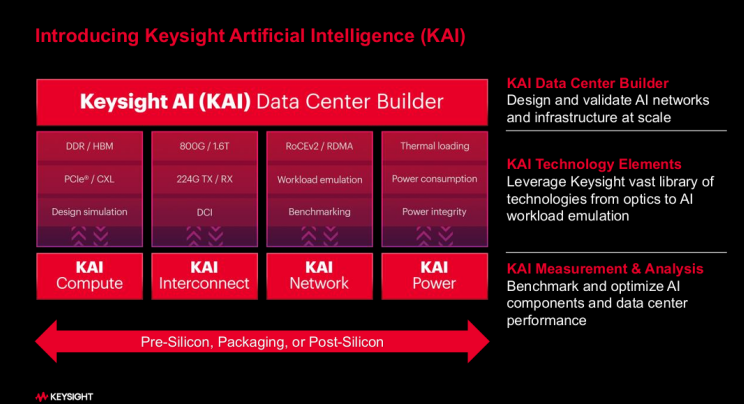
Notably, Keysight Technologies has launched three groundbreaking new products: a 224G sampling oscilloscope utilizing indium phosphide technology to support single/dual-channel 224G data rates; a 1.6T interconnect and network performance tester, a solution with FEC-aware dynamic testing capabilities; and the Keysight AI Data Center Builder, which can accurately simulate burst traffic to preemptively expose large cluster concurrency bottlenecks. This workload simulation solution focuses on emulating complex network loads generated by real AI training, generating large-scale, high-fidelity traffic models to identify network bottlenecks, evaluate the efficiency of switch and network card scheduling algorithms, predict system performance under extreme traffic conditions, and optimize network configurations, thereby reducing GPU wait times and enhancing overall cluster efficiency.
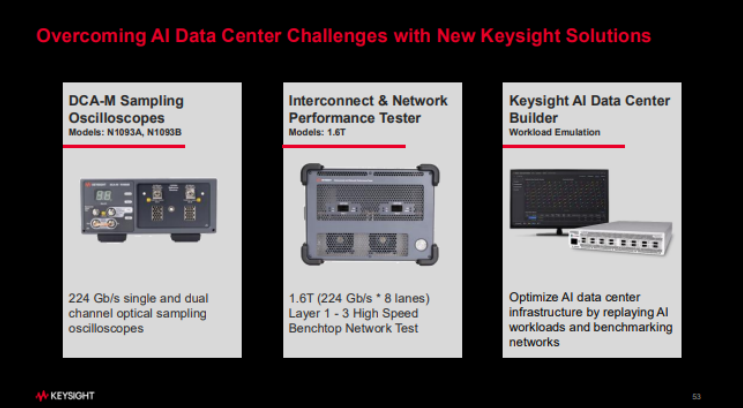
Deeply embedded in China's innovative ecosystem, Keysight Technologies is jointly shaping a 6G-AI integrated future.
Marie Hattar, Senior Vice President and Chief Marketing Officer of Keysight Technologies, stated that the company has been deeply entrenched in the Chinese market for over 40 years, with over 1,000 employees and offices in more than 10 cities, committed to supporting Chinese customers in accelerating innovation. She emphasized that China has set a global benchmark in cutting-edge AI domains such as robotics, large models, and computer vision.
Keysight Technologies views the Chinese market as a hub of innovation. Facing the convergence trend of 6G and AI technologies, Keysight has initiated a dual-track layout plan for 6G technology foresight and localized innovation engines. In terms of 6G technology foresight, Keysight provides low-phase-noise signal sources for 6G communication applications. For localized innovation engines, Keysight's CCO (China Communication Operation) in Beijing, as "one of Keysight's largest application software R&D centers," supports test solutions for 5G-A/WiFi 7; Keysight also engages with local customers and partners through digital platforms like WeChat and Bilibili.
Li Jian emphasized that the AI sector still enjoys a golden period of 5-10 years. Keysight Technologies will adhere to the concept of "full stack and full lifecycle," significantly enhancing the return on investment for computing power infrastructure. Additionally, regarding the commercialization of 6G, Keysight Technologies stated, "6G is not a replacement for 5G, but an enhancement. We are promoting air interface forward compatibility to ensure that more 5G infrastructure can be reused."
While the industry pursues large models with hundreds of billions of parameters, Keysight Technologies is addressing the fundamental issue of generating more effective computations per watt of power. Overall, from its inception as part of Hewlett-Packard in 1939 to its current status as a leader in AI data center testing, Keysight Technologies has consistently been at the forefront of technological evolution. The release of the KAI solution not only equips chip manufacturers and supercomputing centers with a full-stack tool chain, spanning from pre-silicon verification to cluster deployment, but also underscores Keysight's leadership in propelling the test and measurement industry into the AI-driven era.
Looking ahead, Keysight Technologies will continue to deepen its presence in the Chinese market, foster greater collaboration with local enterprises, and actively participate in AI-related associations and organizations to jointly advance the development of relevant standards. Keysight Technologies affirmed that the company firmly believes that the artificial intelligence market holds immense potential and is just beginning, with numerous opportunities yet to unfold. The company will continue to accelerate innovation through leading test and measurement solutions, collaboratively creating a safe and connected world.

